Abstract
Galloping-based piezoelectric energy harvesting systems are being used to supply renewable electricity for low-power wireless sensor network nodes. In this paper, a W-shaped bluff body is proposed as the core component of a piezoelectric wind energy harvester. Experiments and simulations have shown that the W-shaped bluff body can improve harvesting efficiency at low wind speeds. For the W-shaped structure, the finite element simulation results indicate that the structure can help improve the aerodynamic performance to obtain high aerodynamic force. The experimental results demonstrate that compared with the traditional bluff bodies, the piezoelectric wind energy harvester with the W-shaped bluff body (WEHW) can generate higher output voltages and has a lower cut-in speed. When the length L is 30 mm and the rear groove angle β is 30°, the W-shaped structure can induce the best harvesting performance. When an external load resistance of 820 KΩ is connected and the wind speed is 5 m/s, the WEHW generates an average output power of 0.28 mW.
1. Introduction
With the continuous development of wireless sensor network (WSNs) technology in pipeline gas monitoring, intelligent transportation, disaster warning, and other aspects [1,2,3,4], higher requirements have been put forward for rechargeable batteries [5]. However, waste batteries place a heavy burden on environmental protection [6]. To lessen the environmental pollution caused by waste batteries, the employment of self-powered technology to provide energy for WSNS has attracted widespread attention. Common energy harvesting methods that can be used for self-powered technology include ways of being piezoelectric [7], electromagnetic [8], electrostatic [9], triboelectric [10], etc. Among these methods, piezoelectric generating is widely applied to drive microelectronic devices due to its advantages of good stability, low price, and high energy density [11,12,13].
Among various renewable energy sources in nature, wind energy is regarded as clean energy that can be harvested and utilized due to its abundant distribution. Some small-scale flow-induced vibration (FIV) harvesters have been extensively investigated in the field of wind energy harvesting [14]. Naqvi et al. [15] summarized a variety of harvesters and energy harvesting modes used by other researchers to harvest energy from fluid flow. Among them, the cantilever beam energy harvester is widely used because of its simple structure and mature technology. This is a structure commonly used for energy harvesting consisting of a metal beam and piezoelectric material. It is based on the positive piezoelectric effect and can convert mechanical energy into electrical energy. When a cantilever beam is subjected to an external force (e.g., vibration or pressure), its piezoelectric material layer develops a strain, which creates a voltage difference between the two sides of the material. This voltage difference can be harvested and used to power electronic devices. Naqvi et al. mainly categorized the FIV cantilever beam harvesters into four modes: vorticity-induced vibration (VIV) [16], galloping [17], fluttering [18], and buffeting [19].
Galloping is a typical self-excited vibration phenomenon caused by aeroelastic instability. It generally occurs in elongated structures with complex irregular non-streamlined sections such as rectangles, right angles, and so on. The mechanism of galloping is that the negative slope of the lift curve results in a negative damping effect of the airlift, causing the structure to vibrate by absorbing external energy. It is usually related to the velocity and direction of the airflow and exhibits low frequency and large vibration amplitude. Compared with other FIV modes, its aerodynamic modeling is simple and has the characteristic of large vibration amplitude. Therefore, this paper mainly studies energy harvesters based on galloping mode. At present, research on improving the output performance of harvesters mainly focuses on the following directions [15]: optimization of the structure of the harvester, coupling of multiple energy harvesting methods, and optimization of the geometric shape of the bluff body.
Lim et al. [20] proposed a self-regulating wind energy harvester using a rotating base. Compared with the static base, the rotating base structure can reduce the impact of natural wind instability and obtain higher output power. Xiong et al. [21] proposed a spring-coupled electromagnetic energy harvester. The coupled spring can increase output power by converting the vibration energy generated by bluff body vibration into the elastic energy of the spring. Meanwhile, coupling multiple wind-induced vibration modes can obtain a wider range of operating wind speeds and higher output power. Wang et al. [22] proposed a harvester with spindle and butterfly cross-sections. This design can improve the energy harvesting efficiency at low wind speeds by coupling VIV and galloping phenomena. Compared with a single galloping harvester, this design can efficiently harvest wind energy in a wider range of wind speeds.
In addition, a bluff body is a structure designed to alter the characteristics of fluid flow. It is often used to control or optimize the way a fluid flows through a specific area. In wind energy harvesting, the aerodynamic performance can be improved by modifying the geometric shape of the bluff body, thereby increasing the efficiency of power generation. This is because the aerodynamic performance of the bluff body varies greatly with different cross-sectional shapes. Zhou et al. [23] proposed a curved-plate bluff body. Compared with square or triangular prisms and D-shaped bluff body, the curved-plate structure can improve the power generation performance of the harvester at low wind speeds. Liu et al. [24] proposed a Y-shaped bluff body. When the front half angle is 60° and the rear blade is 2 cm, the output performance of the energy harvester is optimal. The Y-shaped wind energy harvester has a higher output power and lower cut-in speed than the square prism. Bao et al. [25]. proposed a self-adaptive piezoelectric wind energy harvester with a double-airfoil bluff body. The double-airfoil bluff body enhances the harvesting performance of the harvester under time-varying wind speed. Its maximum voltage is 62.3% higher than the traditional wind energy harvesters based on square prisms. Hu et al. [26] proposed a method to improve the performance of the wind energy harvester by adding small rods to the front end of the bluff body. Their experiments confirmed the feasibility of adding attachments to the front end of the square prism. Its maximum power output is 2.5 times that of a conventional harvester with a square prism. Wang et al. [27] proposed a wind energy harvester with Y-shaped attachments. It was shown that the Y-shaped attachment could optimize the aerodynamic performance and increase the output power of the harvester.
In summary, the geometric shape design of the bluff body is crucial for high-performance harvesters. This article focuses on the application of piezoelectric wind energy harvesters in pipe environments, where the volume of the bluff body is crucial. Especially in some space-constrained piping systems, efficient energy harvesting becomes a challenge. Therefore, to ensure that the harvesters efficiently harvest energy while maintaining minimal interference to the airflow within the pipeline, exemplified with a limited bluff body volume of 30 × 30 × 70 mm3 (length × width × height), this paper presents a piezoelectric wind energy harvester with a W-shaped bluff body (WEHW) (Figure 1a). The W-shaped bluff body consists of four thin plates, forming three concave grooves in total, with the front groove angles α1 = α2 and the rear groove angle β. L, D, and H represent the length, width, and height of the bluff body, respectively.

Figure 1.
(a) Schematic of the WEHW; (b) schematic of wind energy harvester with lumped parameters.
When the windward area (D×H) is fixed, the aerodynamic performance of the W-shaped bluff body depends on its geometric shape. And the impact of angle (β) and length (L) on its aerodynamic performance is a complex and multifaceted issue. This typically requires in-depth study through methods such as numerical simulation and experimental tests. Therefore, this paper combines these two methods to conduct a parametric optimization design of the W-shaped bluff body.
2. Theoretical Modeling and Analysis
The working process of the wind energy harvester includes fluid–structure interaction (wind energy being transformed into mechanical vibrational energy) and electromechanical coupling (mechanical vibrational energy being converted into electrical energy). The fluid flow exerts an external force on the harvester to deform it, thereby creating mechanical strain within the piezoelectric layer. The mechanical strain causes the generation of electrical charges in the piezoelectric layer, which are utilized by the harvesting circuit. The response of the circuit feeds back into the piezoelectric structure, altering its shape and thus changing the flow field. These interactions can be described by the control equations of each subsystem and the addition of appropriate coupling terms.
The W-shaped bluff body based on galloping theory determines the process of fluid-structure interaction. The electromechanical coupling process can draw on the research theories and analytical methods of piezoelectric cantilever beam energy harvesters. Currently, the study of wind-induced vibration is largely based on semi-empirical formulas and wind tunnel experiments. These methods can basically describe the impact of various parameters on amplitude and fluid force during the process of fluid–structure interaction. Researchers have conducted theoretical studies on the fluid–structure–electric multiphysics field of wind energy harvesters based on these methods [28,29,30].
The vibration of the WEHW in the airflow is a typical galloping motion. If the torsional motion of the piezoelectric beam is not considered, a lumped parameter dynamical model can be used to describe the WEHW, as shown in Figure 1b, where Mw, kw, and cw are the equivalent mass, equivalent stiffness, and equivalent damping of the system, respectively. Rload is an external resistor, Uout is the output voltage, y is the vertical displacement, and Fy is the aerodynamic force of the bluff body in the airflow field. By combining the Navier–Stokes (NS) equations and electromechanical coupling constitutive equations, the dynamical equations of the system are established as
where σ is the electromechanical coupling coefficient and Ce is the capacitance of the piezoelectric element.
Typically, the aerodynamic force in a simplified model is expressed as
where ρair, CD, and V are air density, drag coefficient, and wind speed, respectively. H and d are the height and characteristic dimension of the bluff body normal to the airflow, respectively. The characteristic of galloping phenomena is that the time scale of object vibration is much larger than the characteristic time scale of fluid, so an aerodynamic model is obtained based on the quasi-steady hypothesis [31]. Introducing the aerodynamic coefficient and using a cubic polynomial approximation of , the mathematical model for the aerodynamic force is given as
The coefficients a1 and a3 are empirical coefficients related to the geometry of the cross-section of the bluff body.
To obtain the dimensionless forms of Equations (1) and (2), we introduce the following dimensionless parameters:
where , , and are dimensionless transverse displacement, dimensionless voltage, and equivalent wind speed, respectively. ψ is the ratio of the mass of equivalent volume of air to the mass of the harvester, γ is the ratio of electromechanical time constants, and κ is the dimensionless electromechanical coupling. is the natural frequency of the harvester. The relationship between the equivalent damping cw and the mechanical damping ratio ξM is . The dimensionless forms of Equations (1) and (2) are given as
The approximate solutions for Equations (7) and (8) can be obtained using the multi-scale method. The displacement of the bluff body and the voltage output can be expressed as [6]
where , , and . is the total damping ratio of the system, where is the electrical damping.
According to Equation (10), it becomes evident that under consistent external conditions, the output performance of the wind energy harvester is mainly influenced by the empirical coefficients a1 and a3. When the windward area is fixed, the coefficients a1 and a3 are mainly determined by the angle β and length L of the W-shaped bluff body. Therefore, the angle and length of the W-shaped bluff body are important design parameters. Within a limited bluff body volume, the impact of these two parameters on the performance of the harvester will be discussed through simulations and experiments.
3. Finite Element Simulation Analysis
3.1. Bluff Body Modeling and Simulation Analysis
This section adopts the average aerodynamic force method proposed by Liu et al. [32]. This method uses finite element simulation to calculate the average aerodynamic force of a fixed bluff body in a flow field over a period of time, thereby evaluating its aerodynamic performance. When the average aerodynamic force is positive, it indicates that the structure is subjected to a significant lift. In this case, the larger the average aerodynamic force, the greater the lift acting on the structure, and the better the aerodynamic performance. Conversely, when the average aerodynamic force is negative, it indicates that the structure is subjected to a significant drag. In this case, the larger the absolute value of the average aerodynamic force, the greater the drag acting on the structure, and the worse the aerodynamic performance.
To reveal the mechanism of this W-shaped bluff body transferring wind energy to mechanical energy, the two-dimensional flow field simulation is performed based on the computational fluid dynamics (CFD) method (Figure 2). The turbulent k–ϵ (SPF) model of the CFD module of COMSOL Multiphysics 6.0 software is used for the fluid simulation. We set the left boundary of the computational domain as the entrance, and the right boundary as the exit. The remaining boundaries are set as no-slip walls. The width (D) of the W-shaped structure is set as 30 mm. The simulated domain has a width of 450 mm and a length of 750 mm. The length and width ratios of the simulated domain to the feature size (D = 30 mm) of the bluff body are 15 and 25, respectively. And the effect of the boundary wall with respect to the W-shaped structure can be ignored.
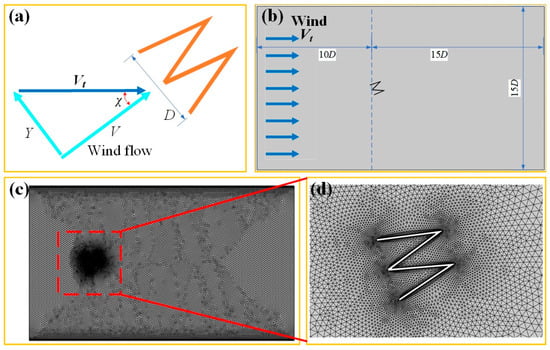
Figure 2.
(a) Description of wind speed during simulation; (b) computational domain; (c,d) mesh configuration for the W-shaped structure.
When the corresponding flow field is analyzed, the bluff body can be assumed to be stationary; then, the wind can be regarded as flowing along a certain angle of inclination to the bluff body. And the speed of the wind is synthesized from the moving speed Y of the bluff body and the actual wind speed V, as shown in Figure 2a,b. The synthetic wind speed Vt and the tilt angle χ are
To obtain a precise solution in a reasonable computational time, three different mesh densities (grid numbers: 29,197 (coarse), 46,918 (medium), 69,968 (fine)) are compared. When the mesh density changes from coarse mesh to medium mesh, the changes of both lift coefficient and drag coefficient are more than 10%. But when the mesh density changes from medium mesh to fine mesh, the changes of both lift coefficient and drag coefficient are less than 1%. So, the medium mesh resolution is selected, as shown in Figure 2c,d.
It is intuitively speculated that the angle (β) of rear groove and the length (L) will inevitably affect the lift force acting on this W-shaped structure. Therefore, we performed a series of two-dimensional flow field simulations of the W-shaped structures with different rear groove angles and lengths. First, the windward width and length of the W-shaped structure are fixed at D = L = 30 mm, and the angles of front groove are kept equal (α1 = α2). The six different angles of rear groove are β = 0°, 10°, 20°, 30°, 40°, 50°. Correspondingly, the angles of front groove are α1 = α2 = 26.6°, 27.5°, 27.9°, 28.1°, 27.8°, 26.9°.
In the simulation, the incoming air with four different speeds flows in from the left side. The bluff body moves upward at a certain speed Y in the direction perpendicular to the air flow. Because the transverse moving speed of the bluff body rarely exceeds half of the wind speed in experiments, the maximum value of the transverse moving speed in the simulation is limited to half of the wind speed, i.e., Y/V < 0.5.
The shear layer is the region created when two fluid layers with different velocities come into contact. In this region, the fluid shear occurs due to velocity differences, i.e., one layer of fluid slides over another. The shear layer is a major source of vortex generation. The large velocity gradient causes relative sliding between the fluid layers, which promotes the formation of vortices. Due to the variation of fluid velocity in the shear layer, according to Bernoulli’s principle, an increase in flow velocity usually leads to a decrease in pressure. Therefore, a significant pressure gradient is generated.
As shown in Figure 3(a1–d6), when airflow passes through the W-shaped bluff body, the shear layer separates from the upper and lower sides of the bluff body at the leading edge. Due to the separation of the shear layer, vortices are formed between the shear layer and the side of the bluff body, creating a negative pressure region. Within one oscillation cycle, when the vortex adheres to the upper surface of the structure, it results in a significant pressure difference between the upper and lower sides of the bluff body. The transverse fluid force reaches its maximum during the oscillation process. The corresponding simulated pressure and vorticity fields are shown in Figure 3(a1–a6,c1–c6). When the vortex adheres to the lower surface of the structure, the transverse fluid force reaches its maximum in the opposite direction (Figure 3(b1–b6,d1–d6)). Conversely, when the pressure on both sides of the bluff body is basically the same, the pressure difference is zero, and the transverse fluid force is minimized. Then, the time-averaged value of the transverse fluid force in one fluctuation period can be regarded as the average aerodynamic force of the W-shaped structure:
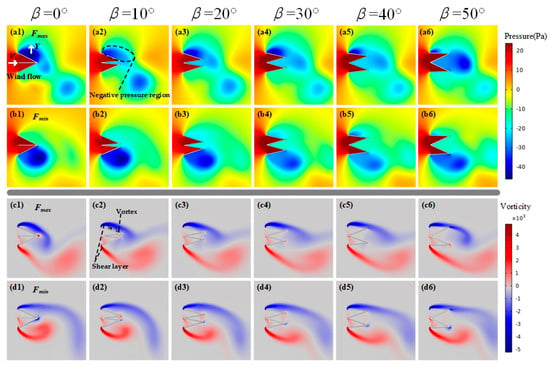
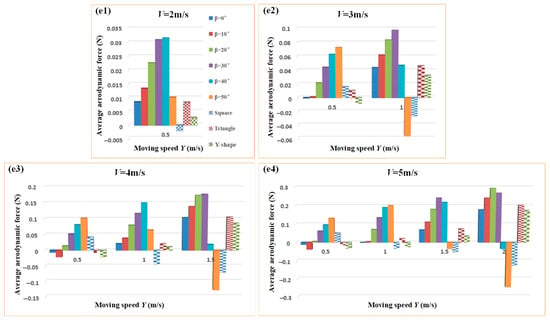
Figure 3.
(a1–b6) Pressure distributions and (c1–d6) vorticity distributions corresponding to the W-shaped structures with L = 30 mm (wind speed V: 5 m/s; moving speed Y: 1.5 m/s). (e1–e4) Average aerodynamic force on the W-shaped structures (β = 0°, 10°, 20°, 30°, 40°, 50°), triangle prism, square prism, and Y-shaped bluff body at different wind speeds V (2, 3, 4, and 5 m/s) and moving speeds Y (0.5, 1, 1.5, and 2 m/s).
For comparison, the simulated average aerodynamic forces on the Y-shaped bluff body, triangular prism, and square prism are also calculated. As shown in Figure 3(e1–e4), when the ratio of transverse moving speed to wind speed (Y/V) exceeds 0.2, the average aerodynamic force on the square prism is negative. This means that if the transverse moving speed of the square prism is large, it will be subject to significant resistance, which will inhibit the large amplitude vibration of the structure. For the triangular prism, only if Y/V < 0.125 does the average aerodynamic force become negative. Meanwhile, this paper simulates the Y-shaped structure (the front half angle is 60° and the rear blade length is 2 cm) proposed by Liu et al. [24]. The simulation results show that the average aerodynamic forces on it are always smaller than those of the triangular prism. This means that compared with the square prism and the Y-shaped bluff body, the triangular prism is subject to stronger airlift force. It is worth noting that under all simulated conditions, the average aerodynamic forces of the triangular prism are always smaller than those of the W-shaped bluff body with β = 30°. Therefore, compared to the three traditional shapes of bluff bodies, the W-shaped bluff body (β = 30°) has better aerodynamic performance.
Apart from β = 20° and β = 30°, the average aerodynamic force of other W-shaped bluff body is negative in some cases. For the structures with β = 0° and β = 10°, the average aerodynamic forces are always less than that of the structure with β = 30° when Y/V < 0.5. Only when Y/V = 0.4, the average aerodynamic force on the structure with β = 20° exceeds that of the β = 30° structure. When Y/V = 0.4, the average aerodynamic force on the structure with β = 40° is negative, i.e., it is subjected to greater resistance. In addition, for the W-shaped structure with β = 50°, the average aerodynamic force increases first and then decreases with increasing transverse moving speed when V = 5 m/s. For the W-shaped structure with β = 30°, the average aerodynamic force is always greater than 0 when Y/V < 0.5, and it increases as the transverse moving speed increases.
The simulation results in Figure 3(e1–e4) are related to the rear groove angle (β) of the W-shaped bluff body. When β = 50°, the larger angle results in strong airflow separation at the front of the W-shaped bluff body. This may cause some of the airflow to bypass the bluff body, enhancing turbulence and thereby reducing aerodynamic forces. When β is between 20° and 40°, moderate angles reduce airflow separation and promote airflow to tightly adhere to the surface. This promotes the recombination of separated airflow at the rear of the structure, improving aerodynamic stability and increasing aerodynamic force. However, when β ≤ 10°, too small an angle results in premature separation of the airflow from the bluff body surface. This prevents the effective flow of airflow along the surface to generate lift. And the separated airflow forms a larger wake region, thereby reducing the aerodynamic force. In summary, compared with the control group, the W-shaped structure (β = 30°) has better aerodynamic performance.
Then, the angle (β) of the rear groove is fixed at 30°. The average aerodynamic forces on the W-shaped structures (L = 5 mm, 10 mm, 15 mm, 20 mm, 25 mm, 30 mm), triangular prism, square prism, and Y-shaped bluff body were simulated under different wind speeds, as shown in Figure 4. When Y/V < 0.5, the average aerodynamic force on the W-shaped structure with L = 30 mm is always positive and increases as the transverse moving speed increases. Compared with the control group, the average aerodynamic force on the W-shaped structure (L = 30 mm) is always greater than that in the other cases.
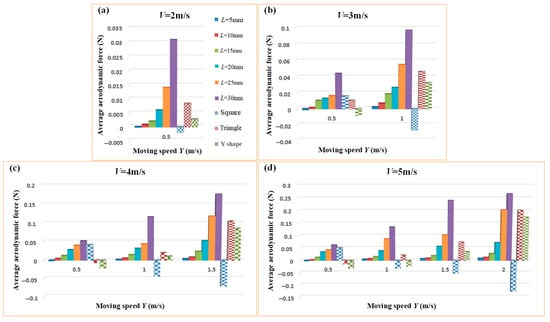
Figure 4.
(a–d) Average aerodynamic forces on W-shaped structures (β = 30°; L = 5 mm, 10 mm, 15 mm, 20 mm, 25 mm, 30 mm), triangular prism, square prism, and Y-shaped bluff body at different wind speeds V (2, 3, 4, and 5 m/s) and moving speeds Y (0.5, 1, 1.5, and 2 m/s).
The simulation results in Figure 4 are related to the length (L) of the W-shaped bluff body. The longer the length of the bluff body, the higher the pressure at the front and top, and the greater the pressure difference with the bottom of structure. Meanwhile, it facilitates the recombination of the separated airflow at the rear of the structure, reducing turbulence in the wake region, thereby enhancing the aerodynamic force. When L ≤ 15 mm, the bluff body becomes too flat, increasing the likelihood of airflow separation. This causes the airflow to bypass the structure and form a larger wake, thereby reducing aerodynamic performance. Therefore, under all simulated conditions, the W-shaped bluff body (β = 30°, L = 30 mm) has better aerodynamic performance than other bluff bodies.
3.2. Modeling and Simulation of Wind Energy Harvesters
3.2.1. Analysis of Output Voltage
The simulation results in Section 3.1 indicate that the W-shaped bluff body (β = 30°, L = 30 mm) has better aerodynamic performance. Greater aerodynamic force can help the harvesters achieve a larger amplitude. Therefore, it is necessary to conduct further simulation and analysis of the power generation performance of the piezoelectric wind energy harvester with the W-shaped bluff body (WEHW). Modeling of WEHW using COMSOL Multiphysics 6.0.
As shown in Figure 5, the whole harvester is in a uniform flow field. To realize lightweight structure design, the bluff body is made of polylactic acid (PLA), which is fixed at the free end of the cantilever beam. The cantilever beam of the harvester is made of phosphor bronze. The piezoelectric elements are made of lead zirconate titanate (PZT-5H) and symmetrically attached to both sides of the cantilever beam. The end of the cantilever beam is set as a fixed end. The distance (X) between the right end of the piezoelectric element and the fixed end of the cantilever beam is 1 mm (Figure 5b). The piezoelectric elements are connected to the circuit as an external terminal, which is connected in parallel with an 820 kΩ resistor. The geometric and material parameters of the harvester are shown in Table 1 and Table 2.

Figure 5.
Dimensions and materials description of the 3D model of WEHW (a) top view of W-shaped bluff body. (b) Illustration of horizontal cantilever beam.

Table 1.
Geometric parameters of the WEHW.

Table 2.
Material parameters of the WEHW.
As shown in Figure 6a, to fully develop the wake and ensure that the boundaries do not affect the flow field around the structure, the size of the flow field area is chosen to be 1000*400*400 mm. The part of the harvester adopts high-precision tetrahedral mesh. The maximum element size is 22 mm, and the minimum element size is 0.05 mm, as shown in Figure 6b. The flow field area grid is automatically generated by the software and set as a dynamic grid. The mesh smoothing type is hyperelastic. It has been verified that there is a good balance between the calculation time and the accuracy of the calculation results using the above mesh parameters.
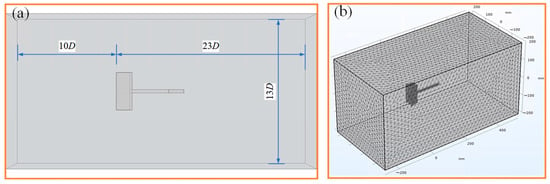
Figure 6.
(a) Position of the WEHW within the computational domain; (b) mesh configuration for the WEHW.
To systematically analyze the power generation performance of the proposed harvester, the output root-mean-square (RMS) voltages of the WEHWs with different geometrical structures were calculated in the wind speed range of 0–5 m/s. The wind speed interval is 0.5 m/s. When the length (L) of the W-shaped bluff body is fixed at 30 mm, the RMS voltages at six cases (β = 0°, 10°, 20°, 30°, 40°, 50°) are calculated as shown in Figure 7a. Within the angle range of 0° to 30°, the RMS voltages of the harvesters increase with the increase in the rear groove angle. When the angle ranges from 30° to 50°, the output voltages of the harvesters decrease with the increase in the rear groove angle. When β = 50°, the output voltage of the harvester drops rapidly. Within the wind speed range of 0–5 m/s, the output voltage of the harvester with β = 30° is always higher than that of the other cases. The above simulation results show that WEHW with β = 30° has better power generation performance compared to the control group.
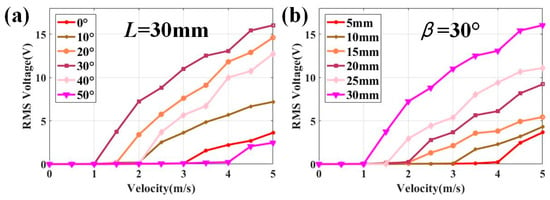
Figure 7.
Output voltages of the wind energy harvesters based on (a) six W-shaped bluff bodies with β = 0°, 10°, 20°, 30°, 40°, and 50°, and L = 30 mm; (b) six W-shaped bluff bodies with L = 5 mm, 10 mm, 15 mm, 20 mm, 25 mm, and 30 mm, and β = 30°.
When the angle (β) of the rear groove is fixed at 30°, the RMS voltages at six cases (L = 5 mm, 10 mm, 15 mm, 20 mm, 25 mm, 30 mm) are calculated, as shown in Figure 7b. The output voltage of the energy harvester increases with the increase in the length of the bluff body. Within the wind speed range of 0–5 m/s, the output voltages of the harvester with L = 30 mm are always greater than those of the other cases. Therefore, within the length range of 5–30 mm, the WEHW with L = 30 mm has a higher energy output compared to the control group.
3.2.2. Analysis of Cut-in Speed
Cut-in speed is the wind speed threshold at which the wind energy harvester enters its effective operational state. When the harvester is designed, it is necessary to ensure that the actual wind speed exceeds the cut-in speed to guarantee continuous and effective energy output. The simulation results in Section 3.2.1 indicate that the WEHW (β = 30°; L = 30 mm) exhibits better power generation performance. Therefore, further analysis of its cut-in speed is conducted through simulation.
Figure 8 illustrates the output voltage and displacement responses of the WEHW (β = 30°, L = 30 mm) at different wind speeds. The time step is 0.1 s. When the wind speed is 1 m/s, the cantilever beam exhibits slight vibration in the initial 2 s, and the maximum displacement is only 0.014 mm. The vibration stops after 3 s. Extend the simulation time to 30 s, and the cantilever beam still does not vibrate so the output voltage is zero. When the wind speed increases to 2 m/s, the harvester enters its effective operational state. Within the first 10 s, the amplitude continues to increase without reaching a steady state. Therefore, the simulation time is extended to 20 s, and the system finally reaches a steady state at 17 s and begins to generate a stable voltage. Within the wind speed range of 2–5 m/s, the time for the harvester to reach a steady vibration state decreases as the wind speed increases; meanwhile, the output voltage increases as the wind speed increases. Especially in the range of 4–5 m/s, the harvester can achieve large amplitudes and generate stable voltages within 2–4 s. When the wind speed reaches 5 m/s, the maximum output voltage of WEHW is 21.5 V, and the maximum amplitude is 35.6 mm. Therefore, the cut-in speed of the WEHW (β = 30°, L = 30 mm) is approximately 2 m/s. This is equal to the minimum gas flow velocity in conventional household and commercial HVAC (heating, ventilation, and air conditioning) system ducts, ensuring that the WEHW can continuously and effectively harvest energy.
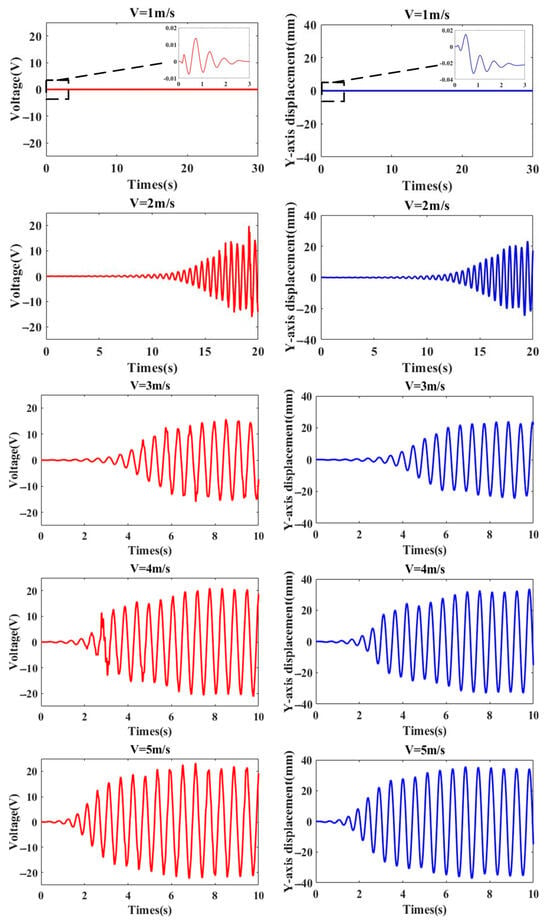
Figure 8.
Voltage and displacement responses of the WEHW within the wind speed range of 1–5 m/s.
4. Experimental Verification
4.1. Experimental Setup
The proposed WEHW prototype is shown in Figure 9a. The WEHW consists of a W-shaped bluff body, a metal cantilever beam, and two piezoelectric sheets. The W-shaped bluff bodies are made by a 3D printer using PLA printing material. And the printing wall thickness is 1 mm. The high-precision structure size ensures the reliability of the test results because the distribution of the flow field is very sensitive to the structure shape. The structural dimensions of bluff bodies are the same as those cases in the above simulation. The actual picture is shown in Figure 9b.
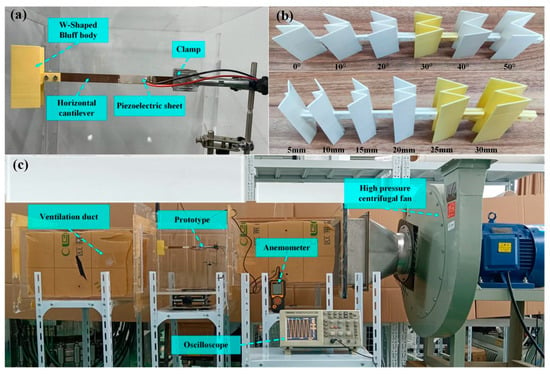
Figure 9.
(a) Test prototype of wind energy harvester with W-shaped bluff body; (b) 3D-printed prototypes of W-shaped bluff bodies with different geometries; (c) experimental setup of the WEHW.
To meet the demand for significant vibration of the harvester, the rectangular cantilever beam is made of phosphor bronze and has appropriate structural dimensions (length × width × thickness = 180 × 10 × 1 mm3). Phosphor bronze has good elasticity and fatigue resistance. When used in piezoelectric cantilever beams, it has the advantages of long service life and high electromechanical coupling performance. The W-shaped bluff body is bolted to the free end of the metal cantilever beam. The fixed end of the cantilever beam is mounted on the base. Two PZT-5H piezoelectric sheets (length × width × thickness = 40 × 20 × 0.2 mm3) are symmetrically pasted on the cantilever beam by epoxy resin adhesive and connected in parallel with the load resistance.
Figure 9c shows the test system of the WEHW, including a high-pressure centrifugal fan, a ventilation pipe, a wind energy harvester with a W-shaped bluff body, a anemometer, an oscilloscope, and several wires. The wind tunnel is composed of a high-pressure centrifugal fan and a ventilation pipe. The high-pressure centrifugal fan uses a type 9–19 high-pressure centrifugal fan produced by Zhejiang Shenli Explosion-proof Mechanical and Electrical Co., Ltd. (Zhejiang, China) to provide wind energy. The wind speed can be adjusted through the control panel. The cross-section size of the inner cavity of the ventilation pipe is 0.4 × 0.4 m2, the pipe length being 1.45 m. The anemometer, HC-001, is produced by Shenzhen Dongmei Measuring Instrument Co., Ltd. (Shenzhen, China) to measure wind speed. The digital storage oscilloscope, Tektronix TDS2012, is produced by American Tektronix Company (Shanghai, China) to collect the voltage signal. Finally, the voltage signal is simply processed by the computer.
4.2. Impedance Matching
Impedance matching is the key to realizing efficient energy transfer from energy source to load. Especially for piezoelectric energy harvesters, the energy harvesting efficiency is significantly affected by the load resistance. There usually exists an optimal resistance value to maximize energy output. In complex actual application environments, it is difficult for theoretical models to take into account all influencing factors. Experimental methods can be tested and adjusted directly under actual conditions to determine the optimal load resistance value. Therefore, to achieve the optimal output performance of the wind energy harvester, experiments for obtaining the optimal resistance of the WEHW were performed first.
In the wind tunnel test, the wind speed span is selected at a relatively low (3 m/s), moderate (4 m/s), and high (5 m/s) wind speed to complete the test. The test load resistance value ranges from 1 kΩ to 1 MΩ. After the stable periodic oscillation of the wind energy harvester occurs, the average output power is obtained according to the formula Pave = Vrms2/R. Vrms represents the root mean square value of the output voltage. Figure 10 illustrates the effect of the external load resistance on the output average power of the WEHW (β = 30°, L = 30 mm) under different wind speeds.
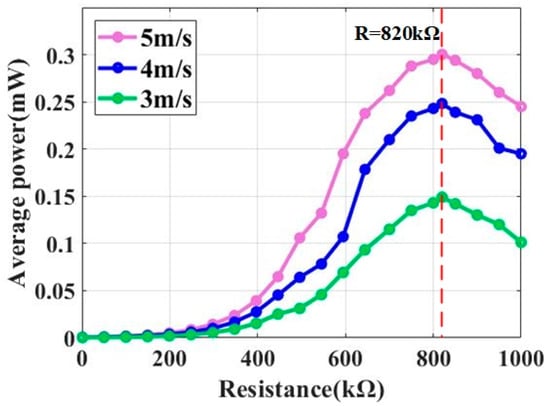
Figure 10.
Effects of external load resistance on the average power at wind speeds of 3 m/s, 4 m/s, and 5 m/s, respectively.
Figure 10 shows that the average output power of the WEHW (β = 30°, L = 30 mm) increases with the increase in wind speed. However, as the load resistance increases, the average power first increases and then decreases. Under the three test wind speeds, the average power peak occurs when the resistance value reaches 820 kΩ. The optimal load resistance is the external load resistance when a wind energy harvester outputs maximum power, so the optimal load resistance is approximately 820 kΩ, which hardly changes with the wind velocity. Next, the optimal load resistance is applied in the wind energy harvesting experiment for all the bluff bodies at different wind speeds.
4.3. Analysis of Harvesting Performance
When the height of bluff body (H) is set at 7 cm, multiple experiments are conducted to measure the root mean square (RMS) value of the output voltage. The following output voltages represent the average of these measurements. When the length (L) of the bluff body is fixed at 30 mm, the generated voltages at six cases (β = 0°, 10°, 20°, 30°, 40°, 50°) are measured, as shown in Figure 11a. Within the angle range of 0° to 30°, the output voltages of the energy harvesters increase with the increase in the rear groove angle. Within the angle range of 30° to 50°, the output voltages of the harvesters decrease with the increase in the rear groove angle. When the rear groove angle (β) reaches 50°, the output voltage of the harvester drops rapidly. For the case of β = 30°, the output voltage can reach 15.2 V due to the large cantilever vibration amplitude. Within the wind speed range of 0–5 m/s, the output voltage of the harvester with β = 30° is consistently higher than the reference group, indicating better energy harvesting performance.
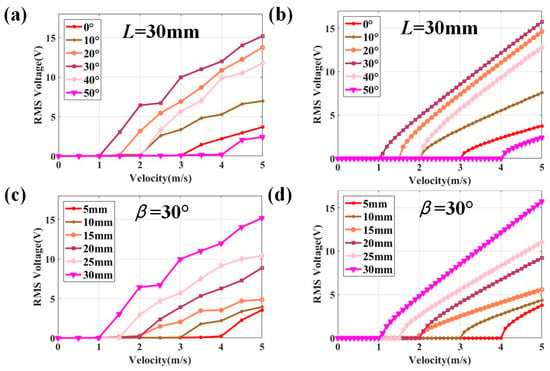
Figure 11.
(a) Experimental and (b) theoretical voltages of the wind energy harvesters based on six W-shaped bluff bodies with β = 0°, 10°, 20°, 30°, 40°, 50°, and L = 30 mm. (c) Experimental and (d) theoretical voltages of the harvesters based on six W-shaped bluff bodies with L = 5 mm, 10 mm, 15 mm, 20 mm, 25 mm, 30 mm, and β = 30°.
Then, the angle (β) of the rear groove is fixed at 30°. The generated voltages at six cases with different lengths (L = 5 mm, 10 mm, 15 mm, 20 mm, 25 mm, 30 mm) are shown in Figure 11c. The output voltages of the energy harvesters increase with the increase in the length of the bluff bodies. When the length L is less than 15 mm, the voltage drops sharply. The voltages of the harvesters with L = 5 mm and L = 10 mm never exceed 4 V. Within the wind speed range of 0–5 m/s, the output voltage of the harvester with L = 30 mm is always greater than that of other cases. Therefore, in the length range of 5–30 mm, WEHW with L = 30 mm has a higher energy output than the reference group. The above experimental results demonstrate that under the condition of keeping the windward area unchanged, adjusting the rear groove angle and length can greatly improve the performance of the corresponding wind energy harvester.
To verify the correctness of the theoretical model, the experimental results were compared with the calculated results of the theoretical model. Some key parameters are determined by experimental measurement, as shown in Table 3. The theoretical voltage of the WEHW can be calculated through Equation (10). By calculating the output voltages of harvesters at different wind speeds in Section 3.2.1, the values of the coefficients a1 and a3 in Equation (10) can be obtained by fitting, as shown in Table 4 and Table 5. When the rear groove angle (β) and the length (L) change, the values of a1 and a3 need to be adjusted correspondingly. The above parameters and coefficients are brought into the theoretical model of the WEHW. The theoretical voltage values at different wind speeds can be obtained by calculating Equation (10) using MATLAB (R2017b) software, as shown in Figure 11b,d. The specific experimental measurement data and percentage differences are shown in Table 6 and Table 7. Comparing the experimental data in Figure 11a,c, the theoretical model voltage curve of the wind energy harvester is in good agreement with experimental data, which verifies the accuracy of the theoretical model. However, the discrepancy between theoretical results and experimental data still exists. The possible reason for their difference is that the galloping theoretical model is based on the small angle of attack hypothesis and the empirical coefficients a1 and a3.

Table 3.
Key parameters of the WEHW.

Table 4.
Values of a1 and a3 with L = 30 mm and different rear groove angles β.

Table 5.
Values of a1 and a3 with β = 30°and different bluff body lengths L.

Table 6.
Experimental measurement data and percentage differences with L = 30 mm and different rear groove angles β.

Table 7.
Experimental measurement data and percentage differences with β = 30°and different bluff body lengths L.
From Figure 11a,c, the WEHW (β = 30°, L = 30 mm) has the highest output voltage. The corresponding output voltage and power are further compared with those of the traditional harvesters with equilateral triangle prism, square prism, and Y-shaped bluff bod (Figure 12). The bluff bodies have the same cross-section size (30 × 30 mm2) and height (7 cm). The corresponding average powers are achieved by Pave = VRMS2/R, as shown in Figure 12b.
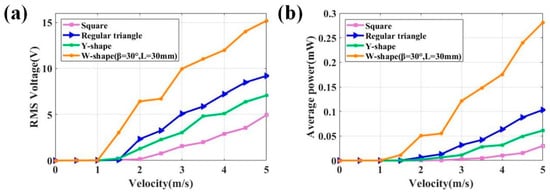
Figure 12.
(a) Generated RMS voltages and (b) average powers of the wind energy harvesters with W-shaped structure, triangle prism, square prism, and Y-shaped structure.
In the reference group, the harvester with the square prism generates the lower output power. Obviously, the WEHW (β = 30°, L = 30 mm) has the best harvesting performance. The corresponding RMS voltage of the case at 5 m/s can reach 15.2 V, while the RMS voltages of the three other cases with triangle prism, square prism, and Y-shaped bluff body are only 9.2 V, 5.0 V, and 7.1 V, respectively. The average output power of the WEHW (β = 30°, L = 30 mm) is 10 times higher than that of the square prism, 2.9 times higher than that of the triangle prism, and 4.9 times higher than that of the Y-shaped bluff body. For the W-shaped bluff body, the RMS voltage reaches 7.2 V at a wind speed of 2 m/s, while the voltages of the other three kinds of harvesters are no more than 5 V, which means the WEHW has a lower cut-in speed than three other traditional structures.
The performance of harvesters is not only determined by the output voltage and power. Small wind energy harvesters need to possess a high-power density to ensure better compatibility with the environment and MEMS. The related parameters of several typical galloping experimental results are summarized as shown in Table 8. Power density is defined as the power output per unit volume, expressed as . Po is the average output power; Ve, Vc, and Vw are the volumes of the piezoelectric sheet, the cantilever beam, and the bluff body, respectively [33]. Compared with Nos. 1–8 harvesters, the width (3 cm) and height (7 cm) of the W-shaped bluff body in our work is the smallest, but the power density (31 μW/cm3) is the highest. The WEHW uses the same PZT-5H piezoelectric material as the No. 7 harvester but with a power density 316% higher than the No. 6 harvester. It is worth noting that at a wind speed of 5 m/s, the power density of WEHW is 22 times that of the No. 7 harvester. The cost of PZT-5H piezoelectric material is only 1/40 of the piezoelectric fiber composite materials (MFC) used in other harvesters. Therefore, the WEHW can meet the superior output performance under the premise of higher economic benefits.

Table 8.
Comparison results of various galloping wind energy harvesters.
5. Conclusions
This paper proposes a novel piezoelectric wind energy harvester with a W-shaped bluff body (WEHW). Based on its theoretical model, we analyzed the influence of critical geometric parameters of the bluff body on output performance. For the proposed W-shaped structure, the finite element simulation results indicate that the structure can help improve the aerodynamic performance to obtain high aerodynamic force. Moreover, the experimental results show that the WEHW can generate higher output voltage than the conventional cross-section (square, equilateral triangle, and Y-shaped) bluff bodies, and has a lower cut-in wind speed. Especially when the length L is 30 mm and the rear groove angle β is 30°, the W-shaped structure can induce the best harvesting performance. When an external load resistance of 820 KΩ is connected and the wind speed is 5 m/s, the average output power of WEHW is 0.28 mW and the power density is 0.031 mW/cm3. The piezoelectric material of the WEHW is PZT-5H. Compared with piezoelectric fiber composite materials (MFC), PZT-5H has lower cost and higher economic benefits. When the application scenario allows for a larger bluff body volume, the influence of the length of the W-shaped bluff body on the harvesting performance can be further investigated in future work.
Author Contributions
Conceptualization, Z.L. and J.Z.; methodology, Z.L. and H.Z.; software, Z.L.; validation, Z.L. and J.Z.; writing—original draft preparation, Z.L.; writing—review and editing, Z.L., H.Z. and J.Z. All authors have read and agreed to the published version of the manuscript.
Funding
This research was funded by the Postgraduate Research and Practice Innovation Program of Jiangsu Province, grant number SJCX23_1495.
Data Availability Statement
Data are contained within the article.
Acknowledgments
The authors of the article appreciate the referees for their valuable suggestions, which contributed to improving the paper.
Conflicts of Interest
The authors declare no conflicts of interest.
References
- Fadel, E.; Gungor, V.; Nassef, L.; Akkari, N.; Malik, M.A.; Almasri, S.; Akyildiz, I.F. A survey on wireless sensor networks for smart grid. Comput. Commun. 2015, 71, 22–33. [Google Scholar] [CrossRef]
- Xu, G.; Shen, W.; Wang, X. Applications of Wireless Sensor Networks in Marine Environment Monitoring: A Survey. Sensors 2014, 14, 16932–16954. [Google Scholar] [CrossRef]
- Rashid, B.; Rehmani, M.H. Applications of wireless sensor networks for urban areas: A survey. J. Netw. Comput. Appl. 2016, 60, 192–219. [Google Scholar] [CrossRef]
- Zhang, J.; Shi, D.; Xing, W.; Sun, J.; Zhu, Z. Study on the spectroscopic parameters and transition probabilities of 25 low-lying states of the AlC+ cation. J. Quant. Spectrosc. Radiat. Transf. 2017, 202, 265–278. [Google Scholar] [CrossRef]
- Muralt, P. Ferroelectric thin films for micro-sensors and actuators: A review. J. Micromech. Microeng. 2000, 10, 136. [Google Scholar] [CrossRef]
- Bibo, A.; Daqaq, M.F. On the optimal performance and universal design curves of galloping energy harvesters. Appl. Phys. Lett. 2014, 104, 023901. Available online: https://pubs.aip.org/aip/apl/article-pdf/doi/10.1063/1.4861599/13545242/023901_1_online.pdf (accessed on 12 July 2022). [CrossRef]
- Fang, S.; Wang, S.; Zhou, S.; Yang, Z.; Liao, W.H. Analytical and experimental investigation of the centrifugal softening and stiffening effects in rotational energy harvesting. J. Sound Vib. 2020, 488, 115643. [Google Scholar] [CrossRef]
- Foong, F.M.; Thein, C.K.; Yurchenko, D. Important considerations in optimising the structural aspect of a SDOF electromagnetic vibration energy harvester. J. Sound Vib. 2020, 482, 115470. [Google Scholar] [CrossRef]
- Erturun, U.; Eisape, A.; West, J.E. Design and analysis of a vibration energy harvester using push-pull electrostatic conversion. Smart Mater. Struct. 2020, 29, 105018. [Google Scholar] [CrossRef]
- Hamid, H.M.A.; Çelik Butler, Z. A novel MEMS triboelectric energy harvester and sensor with a high vibrational operating frequency and wide bandwidth fabricated using UV-LIGA technique. Sens. Actuators A Phys. 2020, 313, 112175. [Google Scholar] [CrossRef]
- Siddique, A.R.M.; Mahmud, S.; Heyst, B.V. A comprehensive review on vibration based micro power generators using electromagnetic and piezoelectric transducer mechanisms. Energy Convers. Manag. 2015, 106, 728–747. [Google Scholar] [CrossRef]
- Yang, Z.; Zu, J. Comparison of PZN-PT, PMN-PT single crystals and PZT ceramic for vibration energy harvesting. Energy Convers. Manag. 2016, 122, 321–329. [Google Scholar] [CrossRef]
- Wang, H.; Jasim, A.; Chen, X. Energy harvesting technologies in roadway and bridge for different applications—A comprehensive review. Appl. Energy 2018, 212, 1083–1094. [Google Scholar] [CrossRef]
- Abdelkefi, A. Aeroelastic energy harvesting: A review. Int. J. Eng. Sci. 2016, 100, 112–135. [Google Scholar] [CrossRef]
- Naqvi, A.; Ali, A.; Altabey, W.A.; Kouritem, S.A. Energy Harvesting from Fluid Flow Using Piezoelectric Materials: A Review. Energies 2022, 15, 7424. [Google Scholar] [CrossRef]
- Rostami, A.B.; Armandei, M. Renewable energy harvesting by vortex-induced motions: Review and benchmarking of technologies. Renew. Sustain. Energy Rev. 2017, 70, 193–214. [Google Scholar] [CrossRef]
- Zhang, L.; Meng, B.; Xia, Y.; Deng, Z.; Dai, H.; Hagedorn, P.; Peng, Z.; Wang, L. Galloping triboelectric nanogenerator for energy harvesting under low wind speed. Nano Energy 2020, 70, 104477. [Google Scholar] [CrossRef]
- Li, K.; Yang, Z.; Zhou, S. Performance enhancement for a magnetic-coupled bi-stable flutter-based energy harvester. Smart Mater. Struct. 2020, 29, 085045. [Google Scholar] [CrossRef]
- Armandei, M.; Fernandes, A.C. Marine current energy extraction through buffeting. Int. J. Mar. Energy 2016, 14, 52–67. [Google Scholar] [CrossRef]
- Lim, Y.Y.; Padilla, R.V.; Unger, A.; Barraza, R.; Thabet, A.M.; Izadgoshasb, I. A self-tunable wind energy harvester utilising a piezoelectric cantilever beam with bluff body under transverse galloping for field deployment. Energy Convers. Manag. 2021, 245, 114559. [Google Scholar] [CrossRef]
- Xiong, L.; Gao, S.; Jin, L.; Guo, S.; Sun, Y.; Liu, F. The Design and Experiment of a Spring-Coupling Electromagnetic Galloping Energy Harvester. Micromachines 2023, 14, 968. [Google Scholar] [CrossRef]
- Wang, J.; Zhang, C.; Gu, S.; Yang, K.; Li, H.; Lai, Y.; Yurchenko, D. Enhancement of low-speed piezoelectric wind energy harvesting by bluff body shapes: Spindle-like and butterfly-like cross-sections. Aerosp. Sci. Technol. 2020, 103, 105898. [Google Scholar] [CrossRef]
- Zhou, C.F.; Zou, H.X.; Wei, K.X.; Liu, J.G. Enhanced performance of piezoelectric wind energy harvester by a curved plate. Smart Mater. Struct. 2019, 28, 125022. [Google Scholar] [CrossRef]
- Liu, F.R.; Zou, H.X.; Zhang, W.M.; Peng, Z.K.; Meng, G. Y-type three-blade bluff body for wind energy harvesting. Appl. Phys. Lett. 2018, 112, 233903. Available online: https://pubs.aip.org/aip/apl/article-pdf/doi/10.1063/1.5029415/14514013/233903_1_online.pdf (accessed on 12 July 2022). [CrossRef]
- Liu, J.; Bao, B.; Chen, J.; Wu, Y.; Wang, Q. Passively adaptive wind energy harvester featuring a double-airfoil bluff body with adjustable attack angles. Mech. Syst. Signal Process. 2023, 185, 109814. [Google Scholar] [CrossRef]
- Hu, G.; Tse, K.T.; Kwok, K.C.S.; Song, J.; Lyu, Y. Aerodynamic modification to a circular cylinder to enhance the piezoelectric wind energy harvesting. Appl. Phys. Lett. 2016, 109, 193902. Available online: https://pubs.aip.org/aip/apl/article-pdf/doi/10.1063/1.4967497/8672168/193902_1_online.pdf (accessed on 12 July 2022). [CrossRef]
- Wang, J.; Zhou, S.; Zhang, Z.; Yurchenko, D. High-performance piezoelectric wind energy harvester with Y-shaped attachments. Energy Convers. Manag. 2019, 181, 645–652. [Google Scholar] [CrossRef]
- Amini, Y.; Emdad, H.; Farid, M. An accurate model for numerical prediction of piezoelectric energy harvesting from fluid structure interaction problems. Smart Mater. Struct. 2014, 23, 095034. [Google Scholar] [CrossRef]
- Akaydin, H.D.; Elvin, N.; Andreopoulos, Y. Energy Harvesting from Highly Unsteady Fluid Flows using Piezoelectric Materials. J. Intell. Mater. Syst. Struct. 2010, 21, 1263–1278. [Google Scholar] [CrossRef]
- Tan, T.; Yan, Z. Analytical solution and optimal design for galloping-based piezoelectric energy harvesters. Appl. Phys. Lett. 2016, 109, 253902. Available online: https://pubs.aip.org/aip/apl/article-pdf/doi/10.1063/1.4972556/14491139/253902_1_online.pdf (accessed on 12 July 2022). [CrossRef]
- Barrero-Gil, A.; Alonso, G.; Sanz-Andres, A. Energy harvesting from transverse galloping. J. Sound Vib. 2010, 329, 2873–2883. [Google Scholar] [CrossRef]
- Liu, F.R.; Zhang, W.M.; Peng, Z.K.; Meng, G. Fork-shaped bluff body for enhancing the performance of galloping-based wind energy harvester. Energy 2019, 183, 92–105. [Google Scholar] [CrossRef]
- Zhou, Z.; Qin, W.; Zhu, P.; Shang, S. Scavenging wind energy by a Y-shaped bi-stable energy harvester with curved wings. Energy 2018, 153, 400–412. [Google Scholar] [CrossRef]
- Yang, Y.; Zhao, L.; Tang, L. Comparative study of tip cross-sections for efficient galloping energy harvesting. Appl. Phys. Lett. 2013, 102, 064105. Available online: https://pubs.aip.org/aip/apl/article-pdf/doi/10.1063/1.4792737/14280753/064105_1_online.pdf (accessed on 15 July 2022). [CrossRef]
- Zhang, L.; Abdelkefi, A.; Dai, H.; Naseer, R.; Wang, L. Design and experimental analysis of broadband energy harvesting from vortex-induced vibrations. J. Sound Vib. 2017, 408, 210–219. [Google Scholar] [CrossRef]
- Zhao, L.; Yang, Y. An impact-based broadband aeroelastic energy harvester for concurrent wind and base vibration energy harvesting. Appl. Energy 2018, 212, 233–243. [Google Scholar] [CrossRef]
- Ding, L.; Zhang, L.; Wu, C.; Mao, X.; Jiang, D. Flow induced motion and energy harvesting of bluff bodies with different cross sections. Energy Convers. Manag. 2015, 91, 416–426. [Google Scholar] [CrossRef]
- Lu, C.; Wu, G.; Xu, C.; Jiang, X.; Tian, F.; Liu, J.; Wang, T.; Wang, X.; Fu, G. Multidirectional galloping-based wind energy harvester based on a cylindrical cantilever beam and multi-tooth blunt body. Phys. Scr. 2023, 98, 055207. [Google Scholar] [CrossRef]
Disclaimer/Publisher’s Note: The statements, opinions and data contained in all publications are solely those of the individual author(s) and contributor(s) and not of MDPI and/or the editor(s). MDPI and/or the editor(s) disclaim responsibility for any injury to people or property resulting from any ideas, methods, instructions or products referred to in the content. |
© 2024 by the authors. Licensee MDPI, Basel, Switzerland. This article is an open access article distributed under the terms and conditions of the Creative Commons Attribution (CC BY) license (https://creativecommons.org/licenses/by/4.0/).